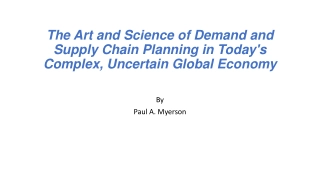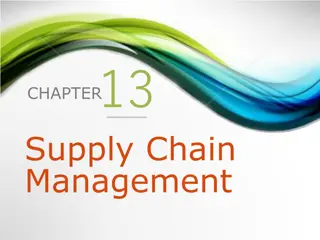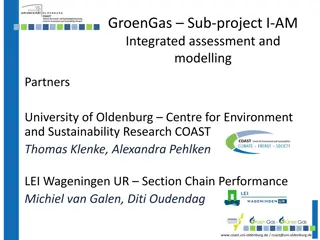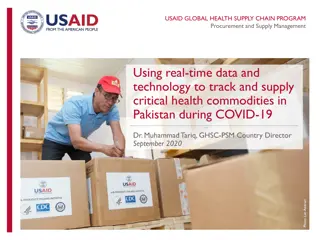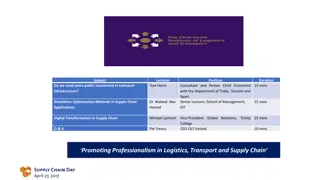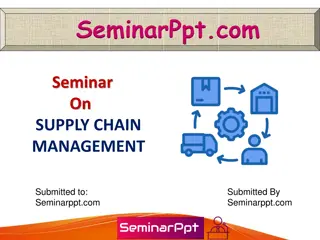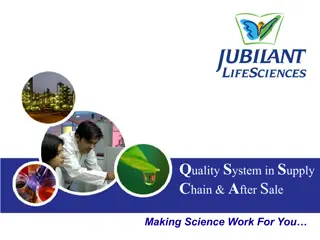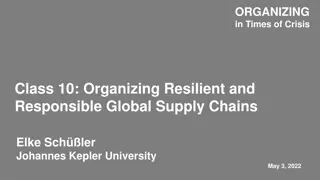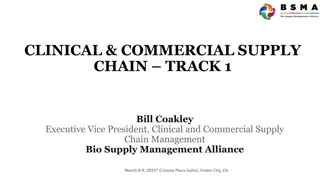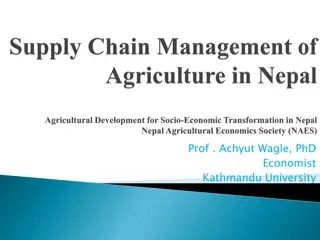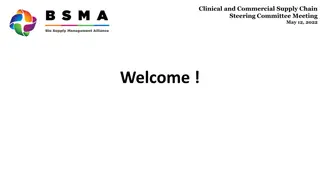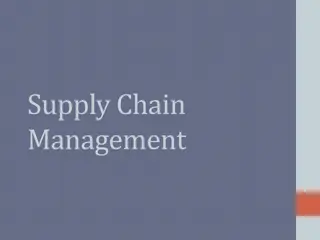
Global Supply Chain Management Insights
Explore key topics in global supply chain management such as production activities, strategic role of foreign production sites, outsourcing decisions, managing dispersed supply chains, and leveraging technology for global logistics. Learn about quality management, production cost relationships, quality improvement strategies, and objectives for international companies in the realm of production and logistics.
Download Presentation

Please find below an Image/Link to download the presentation.
The content on the website is provided AS IS for your information and personal use only. It may not be sold, licensed, or shared on other websites without obtaining consent from the author. If you encounter any issues during the download, it is possible that the publisher has removed the file from their server.
You are allowed to download the files provided on this website for personal or commercial use, subject to the condition that they are used lawfully. All files are the property of their respective owners.
The content on the website is provided AS IS for your information and personal use only. It may not be sold, licensed, or shared on other websites without obtaining consent from the author.
E N D
Presentation Transcript
11 Global Supply Chain (Ch. 15) CYCU Prof. CK Farn mailto: ckfarn@gmail.com http://www.mgt.ncu.edu.tw/~ckfarn/cycu 2022.12
Global Supply Chain Container ships docked at port.
Introduction Interrelated Issues in Global Economy Where to locate production activities. What the long-term strategic role of foreign production sites should be. Whether to own or outsource foreign production activities. How to manage a globally dispersed supply chain and what the role of Internet-based information technology should be in the management of global logistics. Whether to manage global logistics or outsource.
Strategy, Production, and Supply Chain Management 1 Value Creation Activities Production: activities involved in creating a product or service. Supply chain management: the procurement and physical transmission of material through the supply chain, from suppliers to customers. Purchasing. Logistics.
Strategy, Production, and Supply Chain Management 2 Strategic Objectives of the Production and Logistics Function To lower costs. To increase product quality by eliminating defective products from the upstream and downstream supply chain and manufacturing process. Quality refers to reliability.
Figure 15.1 The Relationship Between Quality and Costs
Strategy, Production, and Supply Chain Management 3 Quality Improvement Total quality management (TQM) is a management philosophy with a central focus on the need to improve the quality of a company s products and services. Six Sigma aims to reduce defects, boost productivity, eliminate waste, and cut costs throughout a company. Direct descendant of total quality management (TQM). At six sigmas, a production process would be 99.99966 percent accurate. Some countries have also promoted specific quality guidelines, like the EU s ISO 9000.
Strategy, Production, and Supply Chain Management 4 Two Other Objectives for International Companies 1. Production and logistics functions must accommodate demands for local responsiveness. 2. Production and supply chain management must respond quickly to shifts in customer demand.
Where to Produce 1 Country Factors Location economies. Location externalities. Presence of global concentrations of activities. Issues to consider Formal and informal trade barriers. Transportation costs. Regulations affecting FDI. Expected future movements in exchange rates.
Where to Produce 2 Technological Factors Fixed Costs. If costs are very high, a firm might serve the world market from a single location or from very few locations. If costs are very low, a firm might serve the world market from several locations at once. Minimum Efficient Scale. The level of output at which most plant-level scale economies are exhausted. The larger the minimum efficient scale, the more likely centralized production makes sense.
Where to Produce 3 Production Factors Product Features. Value-to-weight ratio. Universal needs. Locating Production Facilities. Centralized location. Fixed costs are substantial. Minimum efficient scale is high. Flexible manufacturing technologies are available. Decentralizing close to major markets. Fixed costs and the minimum efficient scale of production are low. Appropriate flexible manufacturing technologies are not available.
Table 15.1 Location Strategy and Production 1 Concentrated Production Favored Decentralized Production Favored Country Factors Substantial Few Differences in political economy Substantial Few Differences in culture Substantial Few Differences in factor costs Few Substantial Trade barriers Important in industry Not important in industry Location externalities Stable Volatile Exchange rates
Table 15.1 Location Strategy and Production 2 Technological Factors High High Available Low Low Not available Fixed costs Minimum efficient scale Flexible manufacturing technology Product Factors High Yes Low No Value-to-weight ratio Serves universal needs
Where to Produce 4 The Hidden Costs of Foreign Locations High employee turnover. Shoddy workmanship. Poor product quality. Low productivity.
Make-or-Buy Decisions Make-or-Buy Decisions Decisions about whether to perform a certain value creation activity in-house or outsource it to another firm. Main factors in the decision are cost and production capacity. Other factors include: Product success. Specialized knowledge. Strategic fit. Cost and production capacity. Supplier competencies. Inventory planning.
Figure 15.3 Operationally Favoring a Make Decision
Global Supply Chain Functions 1 Global Logistics Core activities: 1. Global distribution center management. 2. Inventory management. 3. Packaging and materials handling. 4. Transportation. 5. Reverse logistics.
Global Supply Chain Functions 2 Global Logistics continued Global distribution center. A facility that positions and allows customization of products for delivery to worldwide wholesalers, retailers, or directly to consumers anywhere in the world. The foundation of a global supply network. Global inventory management. The decision-making process regarding the raw materials, work-in-process, and finished goods inventory for an MNC.
Global Supply Chain Functions 3 Global Logistics continued Packaging: three different categories. 1. Primary packaging holds the product itself. 2. Secondary packaging contains several primary packages. 3. Transit packaging is used to transport primary and secondary packages. The functions of packaging are to perform, protect, and inform.
Global Supply Chain Functions 4 Global Logistics continued Transportation. Movement of raw material, component parts, and finished goods throughout the global supply chain. Largest percentage of any logistics budget. Ocean is the least expensive and air is the most expensive. Reverse logistics. Process of moving inventory from point of consumption to point of origin for the purpose of recapturing value or proper disposal. Ultimate goal is to optimize the after-market activity or make it more efficient.
Global Supply Chain Functions 5 Global Purchasing Five strategic levels: Level I: domestic purchasing activities only. Level I I: international purchasing only as needed. Level I I I: international purchasing as part of firm s overall supply chain management strategy. Level I V: global purchasing activities that are integrated across the firm s locations worldwide. Level V: global purchasing activities that are integrated across worldwide locations and functional groups.
Table 15.2 Outsourcing Terms and Options A multinational corporation buys products or services from one of its suppliers that produces them somewhere else, whether domestically or globally. Outsourcing A multinational corporation decides to stop outsourcing products or services and instead starts to produce them internally; insourcing is the opposite of outsourcing. Insourcing A multinational corporation buys products or services from one of its suppliers that produces them somewhere globally (outside the MNCs home country). Offshoring A multinational corporation buys products or services from one of its suppliers in a country other than the one in which the product is manufactured or the service is developed. Offshore outsourcing A multinational corporation transfers business or information technology processes to suppliers in a nearby country, often one that shares a border with the firm s own country. Nearshoring A multinational corporation uses both its own employees from inside the firm and an external supplier to perform certain tasks, often in concert with each other. This applies to all four forms of purchasing strategy. Co-sourcing
Managing a Global Supply Chain 1 Efficient Supply Chain Management Can have a substantial impact on a firm s profitability. Four important areas: Just-in-time inventory. Information technology. Coordination. Interorganizational relationships.
Managing a Global Supply Chain 2 Role of Just-in-Time (JIT) Inventory Economizes on inventory holding costs by having materials arrive at a manufacturing plant just in time to enter the production process, and not before. Can result in major cost savings from reduced warehousing and inventory holding costs. Can help firms spot defective parts, take them out of the manufacturing process, and boost product quality. But leaves firms without a buffer stock of inventory, which makes it difficult to respond quickly to problems.
Managing a Global Supply Chain 3 Role of Information Technology Information systems allow firms to optimize production scheduling. Electronic Data Interchange (EDI). Less expensive systems now exist, making it easier for companies of all sizes to access. Blockchain technology is an additional layer in the system.
Managing a Global Supply Chain 4 Coordination in Global Supply Chains Global supply chain coordination: the shared decision-making opportunities and operational collaboration of key global supply chain activities. A more integrated, coherent, efficient, and effective supply chain. Operational objectives: Responsiveness. Variance reduction. Inventory reduction. Shipment consolidation. Quality. Life-cycle support.
Managing a Global Supply Chain 5 Interorganizational Relationships Trust and commitment between interacting organizations are important to an efficient and effective global supply chain.
Figure 15.6 Downstream/Outbound Relationships
Impact of the Macro Environment Stresses on Global Supply Chain Rising tariff barriers. Trade war between U.S. and China. Britain s exit from the European Union. America s retreat from proposed regional trade agreements (Trans-Pacific Partnership). Emergence of virus responsible for COVID-19 disease. Recent turmoil has increased attractiveness of a real hedging strategy. Other changes also impact supply chain decisions. Managers must continually scan global environment.

